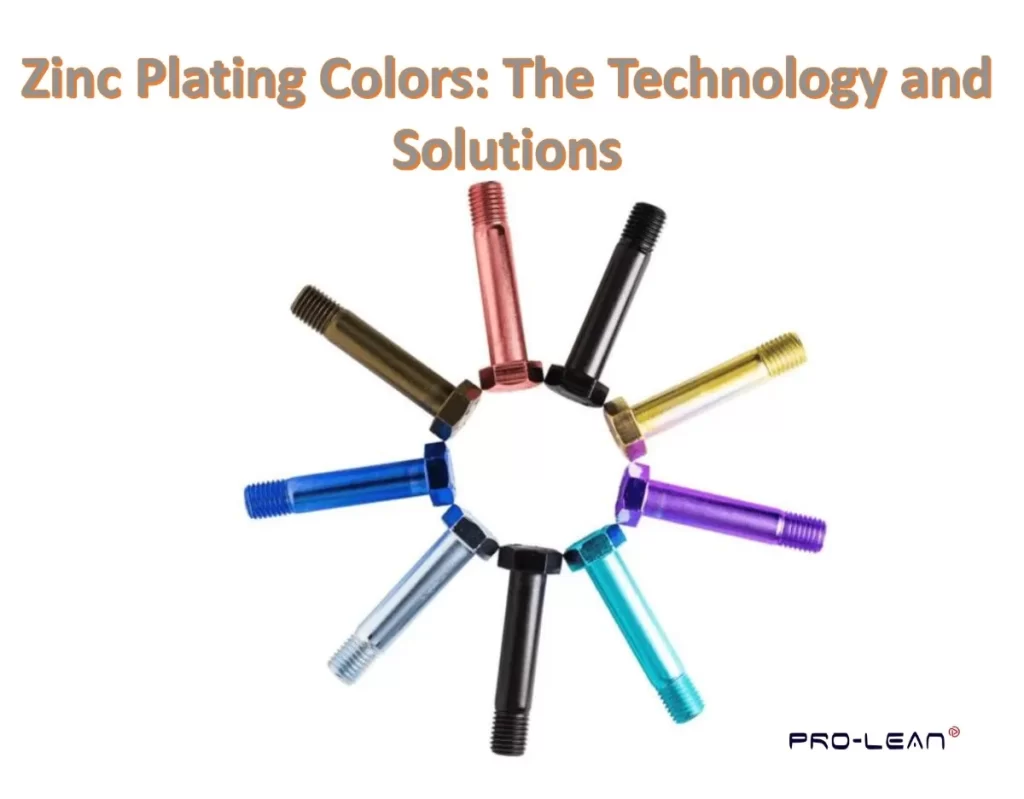 Zinc Plating Colors
Zinc Plating Colors
The finishing process on metal surfaces plays an essential role in the functionality and aesthetics of the part. For providers of different types of zinc-plating, the procedure is mostly about giving the part a protective surface finish.
Zinc plating services at ProleanTech go beyond the ordinary, combining surface protection with visual appeal. Our zinc-plated parts also have better electrical conductivity.
Conventional zinc plating is silvery grey or bluish grey. New surface finishing technologies make it possible to generate more colors, including blue, gold, dark, white, and yellow chromate.
In this article, we will discuss the different zinc-plating colors, their applications, and how Prolean Tech generates these colors.
What is zinc-plating?
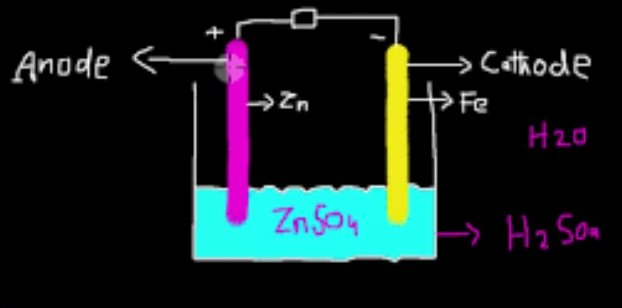
Zinc electroplating setup
To understand zinc-plating colors, it is important to first define zinc-plating. It is the use of specialized equipment to deposit a layer of zinc on base metal. The process, which is demonstrated in the image above, is also called zinc electroplating or galvanization.
Zinc electroplating is an electrochemical process different from hot dip galvanizing, which is characterized by dipping the base metal into hot molten zinc.
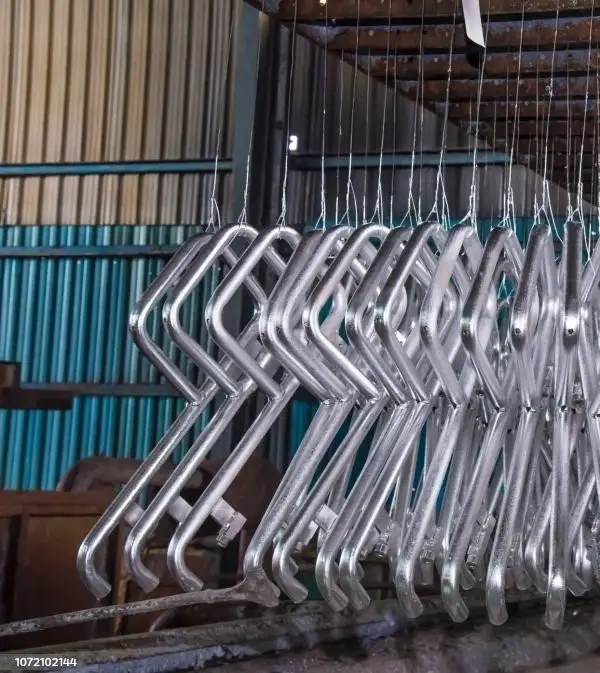
Hot Dip Galvanizing
The zinc-plating Process
The zinc-plating process is complex, but we have perfected it at Prolean Tech. Our capability to match customer expectations and the technicalities of the process is unmatched.
Our engineers are ready to accompany you in every step of the plating process.
We carefully follow the following steps to deliver the best zinc-plating colors.
Step 1: Surface Preparation
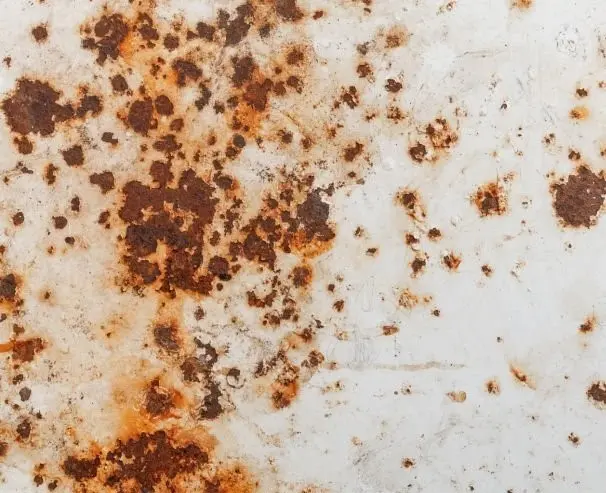
A rusty metal surface
It is important to get rid of all debris, dirt, and rust from the metal surface before electroplating it. An unclean surface is a recipe for poor adhesion, which will affect the functionality of the part in due time.
The ideal cleaning agent for this purpose is an alkaline-based detergent. Follow this up with an acid treatment to remove any remnants of rust from the surface.
Step 2: Prepare the Electroplating Solution
During the zinc-plating process, the substrate is immersed in an electrolyte solution. The name of this solution is the plating bath. This bath contains zinc metal ionic solution plus other chemicals that enhance the process.
Mix all the required chemicals in the right proportions.
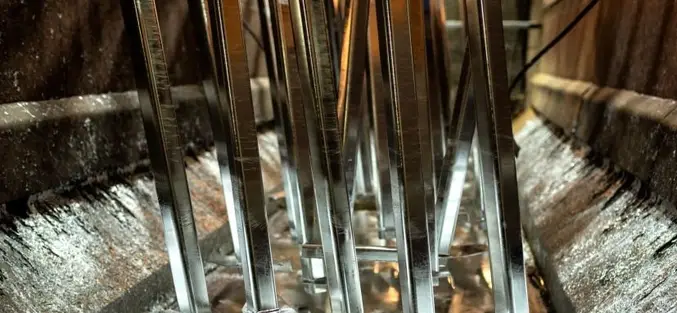
A zinc electroplating bath setup
Step 3: Determine the zinc-plating Procedure
With the solution ready, we now decide which specific zinc-plating procedure to use. The options are mainly barrel plating and rack plating. Barrel plating is characterized by the placement of parts in a barrel. The barrel is rotated at a specified speed leaving the parts zinc-plated.
For rack plating, we fix the parts on a rack and slowly lower the rack in the plating bath container. Unlike barrel plating, rack plating does not move or rotate the parts during the process. Rack plating is also designed for larger parts.
Step 4: Switch on the Electric Current
The process gets its name from the fact that metal ions deposit on the surface of the substrate due to an electric current. The substrate is the cathode because it is the recipient of the electric current.
As the DC flows, zinc ions settle on the cathode. The current circulates until we stop it when enough deposition has occurred.
Step 5: Post-Treatment
The core of the zinc-plating process may be complete at this point, but often, post-treatment is necessary. This is important to remove any remnants or contaminants from the plating bath.
Depending on the level of contamination, the electroplated parts may be rinsed in water several times. After thorough drying, the parts may be subjected to further treatment depending on the requirements.
You can learn more about the fundamentals of the process in this comprehensive guide to zinc-plating.
Try Prolean Now!
How zinc-plating colors are achieved
At Prolean Tech, we believe it is worthwhile for customers to understand how we achieve different zinc-plating colors. Hence, we provide this insightful explanation of the ways to achieve the colors.
First, achieving different zinc colors is related to how the process parameters are controlled. The process parameters include zinc plating thickness and the composition of the electrolyte.
Further, post-plating processes can also help determine the zinc electroplating color. Chromating and passivation are two popular post-processes to produce different zinc-plating colors.
Effect of the zinc-plating process
The appearance and color of the zinc-plated component can be affected by several factors related to the process:
Surface condition of the zinc-plating materials
Machining, heat treatment, and grinding are some manufacturing operations that can affect the appearance and color of the component after it has been zinc-plated.
That’s because these processes affect the surface condition of the zinc-plating materials, which affects the results of zinc electroplating.
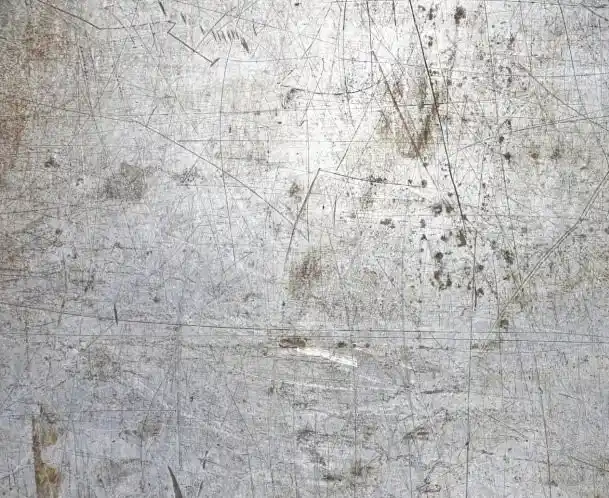
The surface condition can affect the process
Process operating parameters
The zinc electroplating process is designed to work within certain operating parameters. Temperature, process time, concentrations, and pH are some parameters that are typically specified.
However, tactfully modifying and adjusting these parameters can give an interesting zinc-plating color. At Prolean Tech, we know how to manipulate these parameters within the allowable ranges to produce exciting colors on different products.
Process Operating Conditions
The racking method of zinc-plating is commonly used to achieve different colors of the zinc-plated items. How we orient the part and the geometry of the part can contribute to variations in appearance and color after the zinc-plating process.
Experts will tell you that the most effect of these conditions on color is at the contact point between the rack and the component. Professional use of this tactic means being careful not to introduce deficiencies in the process as you try to vary the appearance and color.
Base Material Preparation Before the Zinc-plating Process
There are different techniques of preparing the zinc plated metal for the zinc-plating process. Popular ones are chemical cleaning, abrasive blasting, and chemical activation. All these can have a noticeable effect on the color of the zinc-plated part.
The Chromation Process
Chromate conversion coating can also deliver different zinc-plating colors. A chromate solution and the zinc layer react chemically to produce different colors. To achieve the different colors, you only need to vary the reaction time, immersion temperature, and concentration.
For example, the trivalent chromium process produces a clear zinc coating or blue zinc-plating finish while a hexavalent chromium solution gives a yellow chromate coating.
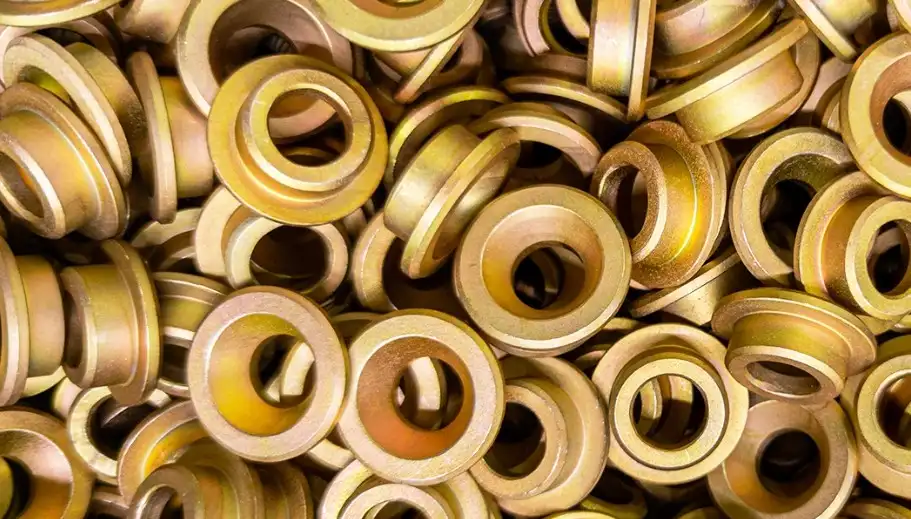
Metal parts with yellow chromate coating
You may also have seen beautiful zinc-plating colors with an iridescent appearance. These are effects of a chromate layer having a transparent oxide layer on top. The effects are akin to what you see when you view soap bubbles from different angles.
Try Prolean Now!
What colors are zinc-plated?
At this point, it is important to identify the different colors or hues possible with zinc-plating services at Prolean Tech. With our unmatched expertise in diverse material finishing, we have many color options.
Next up is a review of some common types of zinc-plating color options.
Blue Zinc
This color is distinctive and appealing to the eye. Manufacturers in the automotive and machinery sectors are very fond of the hue. It is one of the best color options if you are looking for a balance between aesthetics and corrosion resistance. It is also a durable hue, hence its widespread application.
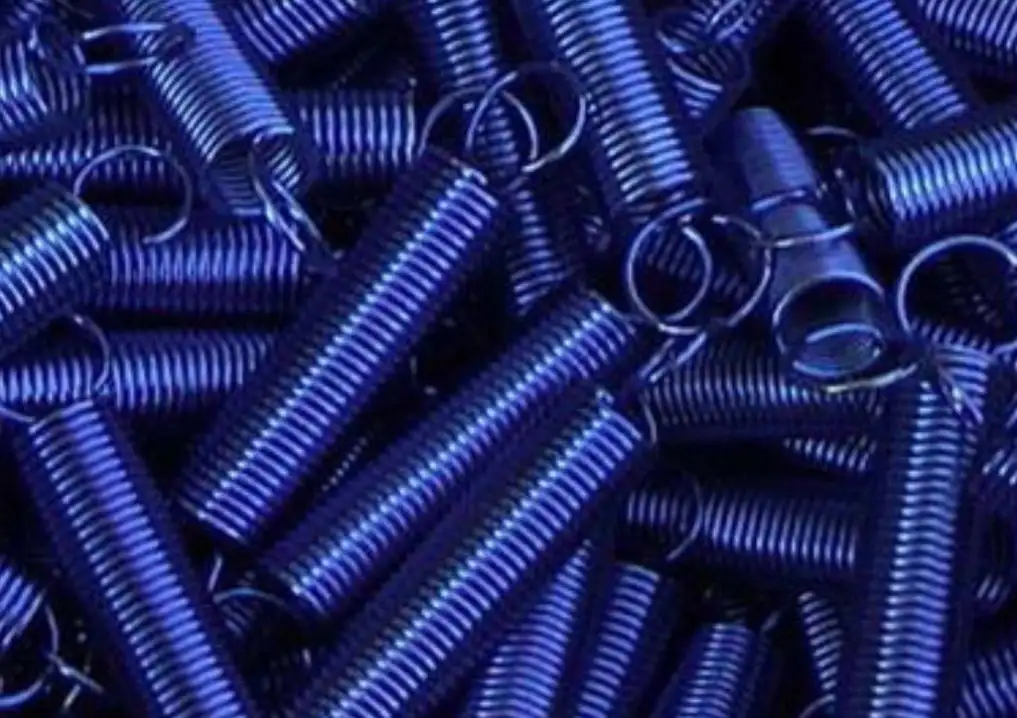
Blue zinc-plated Parts
Green Zinc
This is another unique and appealing zinc-plating color. A quick check on its applications reveals that users value it for its suitability where easy tracking of parts is necessary.
Industries that use color coding rely on the green zinc color a lot. The automotive industry is an excellent example of where green zinc-plating color is widely used for color coding.
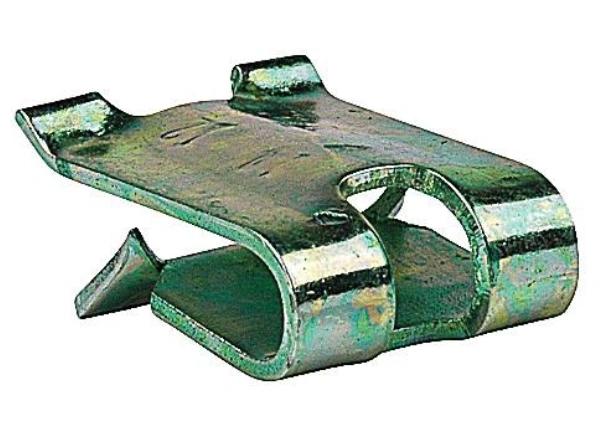
A green zinc-plated part
Matte Black
For those who prefer contemporary-looking parts, the matte black color is a good choice. For its non-reflective but elegant appearance, this color is suitable for many industries that need such subtlety.
Matte black zinc-plating color finds extensive use in automotive and electronic industries. It is highly durable and suits different applications.
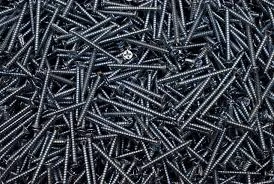
Matte black metal parts
Bright Silver
If you are looking for a bright smooth appearance, the bright silver zinc-plating color is the perfect choice. You will find this hue in parts that emphasize the decorative aspects, for instance in the electronics and consumer goods sections.
The bright silver color is also good for corrosion resistance, so don’t hesitate to use it in outdoor or damp environments.
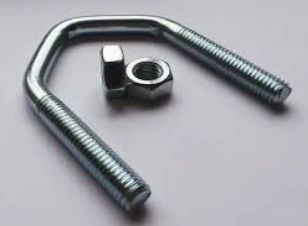
A bright silver zinc plated metal fastener
Gold
Gold color gives the parts an elevated ornamental outlook and value. Of course, the primary benefit of gold color is the visual appeal, but the effect goes beyond this.
Gold zinc-plated components exhibit amazing corrosion resistance, thus they are very long-lasting. These parts are also very versatile, particularly for high-end applications that require a blend of functionality and aesthetics.
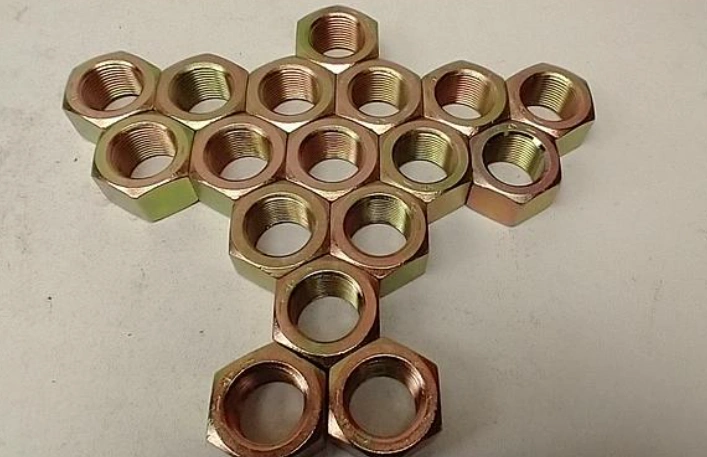
Gold zinc-plated nuts
Zinc-plating Color Services at Prolean Tech
Prolean Tech is a proud provider of zinc-plating services with different hue options. When you come to us, our first step is to evaluate your project requirements.
Our highly experienced team also does a cost-benefit analysis to ensure we are offering the most cost-effective zinc-plating service.
We discuss with the client the ideal solution to ensure cost savings and results that exceed expectations. Contact our industry experts to discover how we are able to handle all custom zinc-plating orders.
Conclusion
If there is a manufacturing process that demonstrates a perfect blend of aesthetics and functionality of parts, it is the zinc-plating colors process. Customers enjoy a lasting enhancement of product appearance and performance.
In this guide, we have provided an in-depth analysis of the zinc-plating colors, laying a strong foundation for anyone looking to define zinc-plating, understand the process and choose the best zinc-plating color for their product.
Whether you are in aerospace, automotive, or electronics, there is always a suitable zinc-plating color or texture for your product.
For the best combination of zinc-plating colors and quality, consider partnering with Prolean Tech, a trusted solution provider for many years. Get your quote now!
FAQs
What is type 3 zinc-plating?
Type 3 zinc-plating is a silver-like hue that is primarily for corrosion resistance. It is simple with a clear zinc coating color.
What is the difference between clear zinc and blue zinc?
Clear zinc is colorless with a silver-like finish while blue zinc has some bluish appearance from the trivalent chromium process. While the two finishes offer corrosion resistance, blue zinc tends to be a little bit better.
What is the difference between Type 1 and Type 2 zinc-plating?
The difference is in the presence or absence of a chromate finish. Type 2 zinc-plating incorporates chromate conversion coating but type 2 plating does not. The chromate finish not only provides color options but also promotes corrosion resistance.
Does zinc-plated go rusty?
Yes, zinc-plated can go rusty, but only if it is used in harsh conditions and is poorly maintained. The plating is effective at keeping rust away because it is the sacrificial cover for the zinc-plating materials.
Effective zinc plating and proper maintenance can keep the plate intact for many years.
How long will zinc-plated last outside?
Depending on the working conditions and maintenance level, zinc-plated can last for several to many years outside. To extend the life of the zinc-plated part, ensure good passivation and increase the zinc plating thickness.
What color does zinc corrode?
Zinc corrosion occurs as a whitish powder that spreads across the surface to prevent further damage.

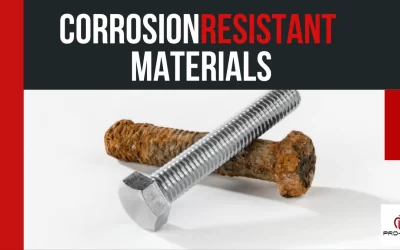
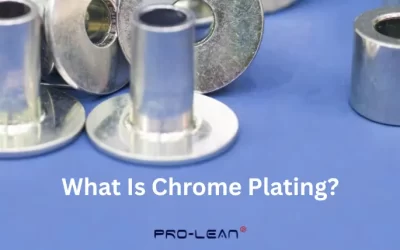
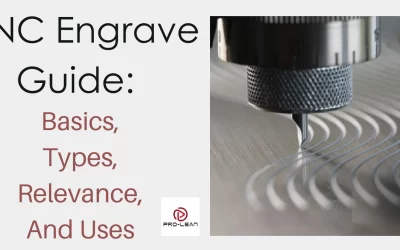
0 Comments